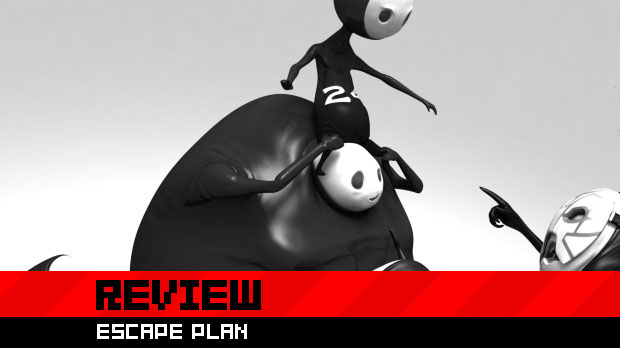Escape Plan has easily been the most intriguing PlayStation Vita launch title on the plate. An all-original property with a deliciously unusual art style, this touch-based puzzle game has long looked like a fantastic way of showcasing the Vita’s multiple interface options. That, and its two monochrome heroes look far too cute for their own good.
It’s just a shame that Escape Plan had absolutely no ambition outside of being a tech demo. A tech demo that doesn’t even work correctly most of the time.

Escape Plan (PlayStation Vita)
Developer: Fun Bits Interactive
Publisher: SCEA
Released: February 14, 2012
MSRP: $14.99
Escape Plan is the tale of two fittingly named protagonists — the diminutive Lil and his hulking ally Laarg — as they attempt to escape their nefarious captor, the masked Bakuki. Fragile and lacking in spatial awareness, our heroes require outside assistance with plenty of environmental manipulation if they’re to avoid being recycled and turned into mindless minions.
Almost everything is interacted with using touch controls on both the screen and rear pad. In order to make Lil or Laarg walk, you swipe over their bodies in the desired direction, while simply tapping on them will cause them to stop. Various environmental features, such as bricks, platforms and elevators, can be manipulated in the same way. For instance, if a brick is in Lil’s way, it needs to be tapped out of his path, otherwise the short-sighted prisoner will trip up and smash his stupid face in. Meanwhile, objects such as fans can be spun around with repeated circular motions, and electric pylons can be pushed into new positions in order to divert their current.
Some objects can be pushed in or out of the environment by touching from the front or rear. Various platforms sunk into walls will need to be interacted with via the touchpad in order to shove them outwards, although many of these platforms will retract after a few seconds so timing is important. The touchpad is also used to interact with other creatures, such as sheep that can be herded with rear swipes, or enemy minions that will respond to sounds created by tapping behind walls. Goading these creatures around the map will be integral to a number of puzzles.
Lil and Laarg use their differing physical forms to perform unique tasks. Laarg can smash through weak walls or floors by quickly swiping over his body to make him tumble forwards or jump. Lil can drink coffee, which will allow him to dash across short distances when squeezed using the touchscreen and touchpad simultaneously. He will also be able to inhale helium and inflate his body, allowing him to float upwards in a direction dictated by tilt controls. Squeezing an inflated Lil will have him fart out a bit of air to change his trajectory, eventually losing enough to gracefully float to the ground.
Escape Plan is broken up into a number of one-screen stages in which our heroes enter through one door of a room and must exit through another. Strangely, a large amount of these rooms feature just one protagonist, with Lil and Laarg only sharing stages toward the end of each chapter. Even when they are both present in a stage, they rarely work together to solve puzzles. Most challenges simply have players navigate the two heroes through a shared room in different ways, rather than have them directly interact. Every now and then Lil might be needed to pull a lever and open a path for Laarg, but such instances are uncommon.
At the end of each stage, players are graded on a three-star scale, determined by how long they took to solve a puzzle and how many gestures they needed to do so. This grading system harks back to the kind of setup one commonly finds in a mobile game, and it’s not the only similarity. From the simple touch controls, small environments, and brief selection of content available, Escape Plan feels like something that could easily be ported over to an iOS device with very little compromise. The only major difference is that this game costs about three times as much as it would on an iPhone.

This wouldn’t be so bad outside of the game’s true problem — Escape Plan just doesn’t work properly. Using a touch screen to perform almost every single task can lead to the interface confusing itself — a problem one would think developers had gotten over by now. For example, if you tap on an object for Lil to interact with, but he’s standing to close to it, the game may just start making Lil walk in a random direction. Often, the touch input is unresponsive and won’t work at all. Many times have I tapped on something and had nothing happen, even if the screen’s ripple effect shows that my finger was definitely in the right place. This is especially aggravating when trying to stop Lil or Laarg from merrily walking over a chasm and into certain death.
By far the worst aspect of the control scheme, however, is its use of the rear touchpad. Escape Plan requires players to be very specific with where they touch, and in certain timed situations where one needs to push out platforms to keep a character from falling, precision isn’t possible. I’m not sure if the developers are aware of this, but the PlayStation Vita is not made out of transparent glass, and as such one cannot see through it to note exactly where one’s finger is on the touchpad. Often is the instance where you’ll be fumbling behind the Vita, desperately hammering to find the one sweet spot that will cause the desired effect. Rare is the moment when this guesswork actually pays off, especially in later levels where players only have a second or two to make the right move.
Herding sheep around is a particularly infuriating endeavor. These random berks will bleat and wander unpredictably whenever touched, and won’t stand still if another sheep draws near. There are a few puzzles that require multiple sheep to stay on pressure switches and keep doors open, but they’re so hard to herd around the screen that getting them in place requires blind luck and the patience of a saint.

One could criticize Escape Plan for having simplistic puzzles that regularly insult one’s intelligence, but I honestly don’t think the restricted controls could handle anything more complex than the remedial assortment of challenges on offer. None of the puzzles are very hard or require much thought, and if one could use more direct, traditional controls, they’d be solved in seconds. Escape Plan‘s challenge lies not in actually solving puzzles, but in wrestling with the confused, unresponsive, frustrating interface. This is a game that was desperate to show off how clever its control scheme was, but didn’t stop to wonder whether the control scheme actually worked.
It’s truly disappointing because Escape Plan can be such a charming little experience when it wants to be. The monochrome visuals are stylish, while the creature and environment design is as dark and disturbing as it is adorable. Every now and then, a truly clever, inspired idea shows up, such as leaky gas pipes that need to be physically plugged with a finger, or molten metal surfaces that must be cooled down with rotating fans. Escape Plan occasionally threatens to be the inventive, surprising puzzle game it could have been, but for every good idea, there are two incompetent ones.

Escape Plan never aims to be anything more than a showcase of the PlayStation Vita’s touch controls, but said controls are so insensitive and poorly implemented that the best it can hope for is to be used as an example of what not to do when designing a Vita game. Do not expect precise commands to be successfully completed from behind a PlayStation Vita, do not confuse a game with multiple touch commands in one place, do not produce something that could have been made for a cellphone and charge triple the asking price.
Ultimately, however, do not be so damn promising, but end up as such a dismal letdown.













Published: Feb 16, 2012 8:15 PM UTC